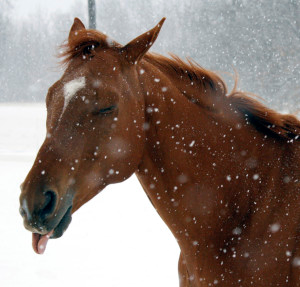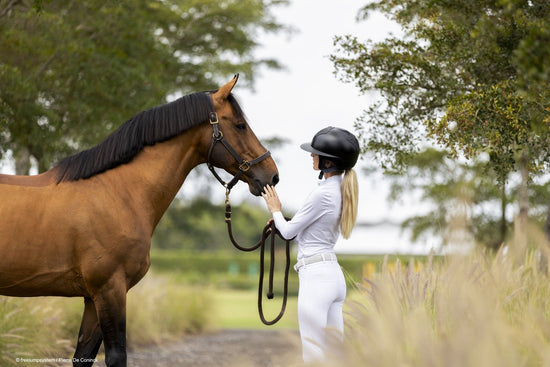In winter it is important that we keep our horses motivated and change up their routine when riding as much as possible. Working every day in the indoor school can not only be boring for you but it is just as boring for your horse. He goes from the stable to the indoor, and on a good day he might get to go for a bit of a free run outside if it’s not too wet or frozen! To keep the motivation levels high, we would like to offer you a few cavaletti and pole exercises that you can incorporate into your everyday riding a few times a week so you and your horse can have a bit of fun.
Cavalettis and poles are great as they help to stimulate your horses mind and concentration so they don’t get bored and they are also great for building muscles and encouraging the joints to become more elastic. The horses need to remain straight over the exercise which is important for both jumping and dressage horses alike. Working with cavalettis and poles helps to loosen and balance your horses stride as they must concentrate on their foot falls. We want to encourage our horse’s necks to lengthen and streeeetch down. Please don’t forget that like everything in life, variety is the key. Don’t stay on one exercise for too long and keep in mind that if the exercise is set up incorrectly it may cause injuries, whereas planned and prepared cavalettis and poles will bring heaps of benefits to you and your horse.
Regardless of whether you are a dressage or jumping rider, beginner or professional or are just looking to do something different with your horse, cavaletti and pole work is great for everyone. In jumping we need our horses to concentrate on the distances of the jumps and the placement of their legs and feet. Cavaletti work is therefore perfect as it puts less strain on joints then jumping big fences but has a similar purpose as the horse must concentrate on placing his feet correctly rather than just trotting or cantering around the school.
Dressage is all about rhythm and control, thanks to cavalettis and pole work you can achieve this in the walk, trot and even canter as the even spaces between the cavaletti ensure movement and length of stride remain the same. For higher level dressage horses pole work can also be used in the pre-training of passage. And of course straight, straight, straight! Straightness is so important in dressage; no one wants to trot up the centre line wobbling around like they are coming home from a night out on the town.
Not only are cavaletti and pole work great for your horse. It is also so beneficial for you as a rider. If you are a beginner, cavaletti and pole work can help you learn how to give to your horse. By giving we mean you don’t hold on to the horse’s head for dear life. Instead you gently release your hands over the poles to allow your horse to move more freely. If you hold onto him he can’t sway and flaunt it over the poles with a beautiful rhythm, instead he’ll be so uncomfortable from all your pressure he’ll look like his got a pole jammed up his …. You know what! The pole work also encourages the rider to learn to “go with” the horse’s movement, instead of sitting backwards and too deep in the saddle the rider must learn to follow the horse’s movement over the exercise.
For jumping riders cavalettis and poles encourage the rider to concentrate on the distance, whether it be in walk, trot or canter. It teaches us to adjust our horses stride so he can come to the poles at the best possible distance. We need to be able to lengthen and shorten the stride at the slightest touch. When I put my leg on I want my horse to react quickly and move forward lengthening their stride. When I use a half halt I need my horse to collect and shorten their stride. This is fundamental for jumping horses.
The dressage rider can also greatly benefit from cavaletti work and poles as it can help develop their seat. Riding sit trot over cavalettis is rather difficult as you can all imagine if you haven’t tried it yet but it actually helps the rider become more aware of their horse’s rhythm and tempo, thus allowing them to realise what it should feel like when the cavaletti/pole is taken away.
And as with the horses cavaletti work ensure that the riders must concentrate on staying straight, keeping the same rhythm, keep your eyes up and stay in the middle at all times.
Introducing Cavaletti Work
Like anything new it can take time. Don’t push yourself or your horse to hard the first few times. Remember Rome wasn’t built in a day and neither was being able to sit trot a row of cavalettis! We would always recommend that you use protection on your horse’s legs, at the very least on the front legs to help prevent unnecessary injuries. If you feel too much resistance during any exercise or your horse seems really unhappy stop! Your horse is maybe trying to tell you that they have pain somewhere and they are trying to let you know that you are hurting them.
When introducing horses to cavaletti work, young or old, tall or small, you should always begin with a straight row of cavalettis in walk so you can build up both yours and your horse’s confidence. Set the poles up at a distance of between 2-2.5 feet (80-90cm) depending on your horse’s size and stride. Ask someone on the ground (if you’re that lucky) to help you the first few times to give your horse a bit of extra encouragement. BUT ground person pay attention and be careful, obviously don’t stand in front of the horse where you might just get trampled over like a bulldozer knocking down a house.
Once your horse is happy and relaxed at walk we can now move onto something a bit faster…..trot! Have your super ground person now space the cavalettis or poles at a 3.5-4 feet distance (about 1.25m). Now pick up trot and trot in a straight line through the cavalettis or poles. Once through the row make sure you stay straight for a few strides after (best until the end of the school) so your horse doesn’t get any ideas about ducking out or dropping their shoulder in after the poles and potentially leaving you in the dirt. And as always, if you do it on the left rein, change sides and do it on the right, no one wants a one sided horse! If your horse gets super excited and decides trot is just to slow for them and canter is all the go gently try to ease him back to trot and continue with the exercise quietly until he understands it’s not a “who can go the fastest” competition. If it’s really too much for them get your super-duper ground person to move the poles back to walking distance until they completely relax. Then start with the trot work again.

A row of trot Cavalettis
Picture from http://www.jumpswest.com/Cavaletti/cavalletti.jpg
We all know that dressage horses need to show off their big extended trots across the diagonal. Sooo, to get that big beautiful trot that everyone will drool over why not place the poles along the diagonal, slightly wider apart (you will need to adjust this alone to what you think your horse is capable of). Doing this will encourage your horse to remain straight across the diagonal (remember no one likes a wobbly drunk in the dressage arena) and by spacing the poles wider apart you will create a bigger stride. Adjust the spacing as you see fit, but remember please don’t do anything drastic not all horses are Totillas or Valegro!
Moving on from straight lines we can also do a similar exercise but on a curved line, called a circle! This is great to encourage flexion and bend in the movement without losing straightness, rhythm or impulsion. It also really helps to activate the horses hind end, making them work hard and creating a better trot at the same time.

Ingrid Klimke demonstrating trot on a bend
Photo from http://www.horsemagazine.com/thm/wp-content/uploads/2015/09/P9040383.jpg
Getting a bit faster and into canter now. Cavaletti and pole work can have amazing results not only for jumping horses but also dressage horses or horses just wanting a bit of fun. The exercises in canter encourage your horse to really come “under” with their hind and sit on their haunches. This is what we want to achieve. Call up your ground person again, more work for them! Get them to adjust the poles to between 9-11 feet (about 2.7-3.3 meters). Feel free to use your ground person to adjust the measurement so that it suits your horses stride, but don’t make it to long as then it defeats the purpose of the exercise and don’t make it too short for inexperienced horses as we don’t want to scare them off just yet! Again we want to start this in a straight line from both reins until we feel that our horses are comfortable. Once the straight line is sorted once again introduce the curved line. It is a fantastic exercise for both horse and rider as the horses must really “bend” and launch from their haunches and the rider needs to concentrate on staying in the centre of the poles and on their position. Make sure you always try to “go” with your horse, don’t stay behind as this will “block” your horse.
A curved line of canter cavalettis
Picture from http://img.liczniki.org/20100805/Cavaletti_xd-1281043363.jpg
If your horse is nervous, canter cavaletti and pole work tends to relax them as canter is usually the horses favourite gait as they feel freest. But as always, keep in mind that these exercises can be very exhausting, especially for young horses. Even though the “jumps” are only small it takes a lot of concentration and works a lot of muscles really hard. It is often much harder than just jumping a few single jumps. Don’t overdo it!

Ingrid Klimke demonstrating canter work on a curved line
Picture from http://www.horsemagazine.com/thm/wp-content/uploads/2015/09/P9040383.jpg
As we have said nearly a million times in this article cavaletti and pole work really is fantastic and totally beneficial for horse and rider when done correctly. Add some into your work tomorrow. Remember start small and build up from there and don’t forget to have fun and always wear a helmet!
Happy riding.




